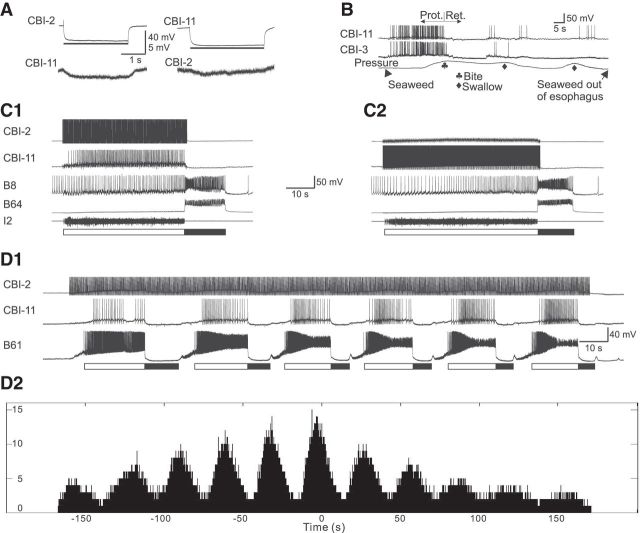Figure 1.
Functional properties and interactions of CBI-11 and CBI-2. A, CBI-11 and CBI-2 are electrically coupled. Negative currents injected into either CBI-2 or CBI-11 (bars) induce hyperpolarization in the other CBI. The electrical coupling appears to be stronger from CBI-2 to CBI-11 than from CBI-11 to CBI-2. B, In a semi-intact preparation, dual recordings of CBI-11 and CBI-3 show that they are activated by food stimuli during the protraction (Prot) phase of biting. Ret, Retraction. C, In an isolated CNS preparation, stimulation of either CBI-2 (C1) or CBI-11 (C2) with short current pulses evokes a single cycle of ingestive motor program in which radula closure B8 is weakly active during the protraction phase (monitored by I2 nerve activity, open bar) but strongly active during the retraction phase (monitored by retraction interneuron B64 activity, filled bar). CBI-11 is recruited into CBI-2-elicited program (C1), but CBI-2 is not recruited into CBI-11-elicited program (C2). D, Continuous stimulation of CBI-2 for 3 min (D1) evokes six cycles of motor programs and CBI-11 is recruited to fire during protraction (monitored by protraction motor neuron B61). CBI-11 exhibits progressively higher activity as more cycles are elicited. D2, Cross-correlogram of spike timing of CBI-11 and B61 in D1 shows that CBI-11 and B61 fired together in bursts, but B61 bursts preceded CBI-11 bursts by ∼4 s.

